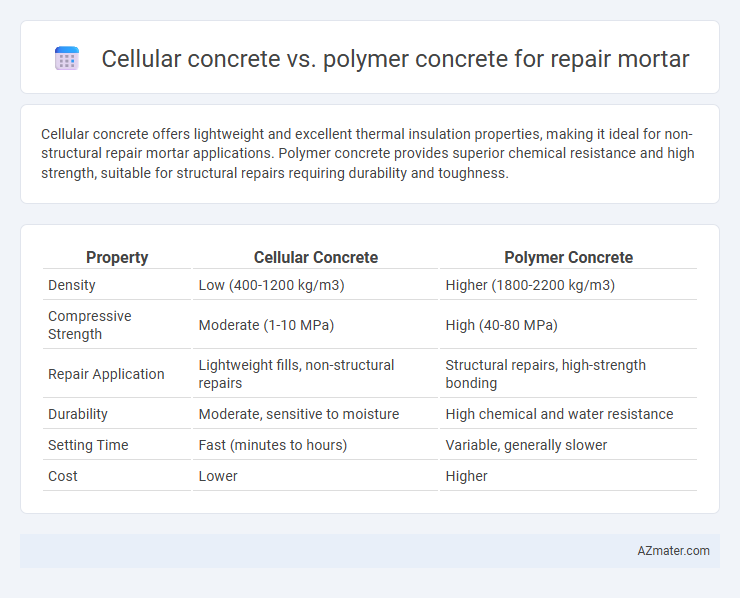Cellular concrete offers lightweight and excellent thermal insulation properties, making it ideal for non-structural repair mortar applications. Polymer concrete provides superior chemical resistance and high strength, suitable for structural repairs requiring durability and toughness.
Table of Comparison
| Property | Cellular Concrete | Polymer Concrete |
|---|---|---|
| Density | Low (400-1200 kg/m3) | Higher (1800-2200 kg/m3) |
| Compressive Strength | Moderate (1-10 MPa) | High (40-80 MPa) |
| Repair Application | Lightweight fills, non-structural repairs | Structural repairs, high-strength bonding |
| Durability | Moderate, sensitive to moisture | High chemical and water resistance |
| Setting Time | Fast (minutes to hours) | Variable, generally slower |
| Cost | Lower | Higher |
Introduction to Cellular and Polymer Concrete
Cellular concrete, characterized by its lightweight, porous structure created by entrapped air bubbles, offers excellent thermal insulation and reduced density for repair mortar applications. Polymer concrete integrates polymer binders such as epoxy or polyester resins, delivering superior adhesion, chemical resistance, and mechanical strength compared to traditional cementitious materials. Both cellular and polymer concretes provide tailored solutions in repair mortar, with cellular concrete optimizing weight and insulation, while polymer concrete enhances durability and bonding performance.
Key Properties of Cellular Concrete
Cellular concrete excels in repair mortar applications due to its lightweight nature, thermal insulation, and excellent workability, which facilitate easy application and curing. Its low density and high porosity significantly reduce structural load while providing superior acoustic dampening and fire resistance. High compressive strength relative to its weight ensures durable repairs, making cellular concrete a preferred choice over polymer concrete where thermal and fire performance are critical.
Key Properties of Polymer Concrete
Polymer concrete exhibits superior tensile strength, chemical resistance, and low permeability compared to cellular concrete, making it highly effective for repair mortars in aggressive environments. Its rapid curing time and strong adhesion to existing substrates enhance durability and structural integrity in repair applications. Polymer concrete's resistance to shrinkage and thermal cycling further ensures long-term performance in critical infrastructure repairs.
Material Composition Comparison
Cellular concrete consists primarily of cement, water, fine aggregates, and a foaming agent, resulting in a lightweight, porous structure ideal for thermal insulation and low-density repair applications. Polymer concrete incorporates a polymer binder, such as epoxy or polyester resins, combined with aggregates, providing superior mechanical strength, chemical resistance, and adhesion properties. The difference in material composition directly influences their performance: cellular concrete offers better insulation and ease of shaping, while polymer concrete excels in durability and structural repair requirements.
Strength and Durability Analysis
Cellular concrete exhibits lower compressive strength ranging between 3 to 15 MPa but offers excellent thermal insulation and lightweight properties, making it suitable for non-structural repair applications. Polymer concrete, with compressive strength often exceeding 40 MPa, provides superior bonding, chemical resistance, and durability in aggressive environments, enhancing the longevity of repaired structures. Strength and durability analysis indicates polymer concrete as the preferred choice for structural repairs due to its enhanced mechanical properties and resistance to degradation, while cellular concrete serves best in lightweight, insulation-focused repairs.
Application Methods in Repair Mortar
Cellular concrete repair mortar is applied using conventional spraying, troweling, or casting methods, benefiting from its lightweight and flowable consistency that allows easy filling of voids and cracks. Polymer concrete repair mortar requires meticulous surface preparation and is typically applied through troweling or spraying, offering superior adhesion and chemical resistance ideal for high-stress or chemically exposed areas. Both materials demand controlled curing conditions, with polymer concrete necessitating longer curing times for optimal strength development.
Cost Comparison: Cellular vs Polymer Concrete
Cellular concrete offers a more cost-effective solution for repair mortar due to its lightweight properties and lower material expenses compared to polymer concrete. Polymer concrete incurs higher costs attributed to expensive resin binders and specialized mixing processes. Overall, cellular concrete is preferred for budget-conscious repairs, while polymer concrete is chosen for durability despite its higher price.
Environmental Impact and Sustainability
Cellular concrete offers substantial environmental benefits due to its use of lightweight, aerated materials that reduce raw material consumption and decrease carbon emissions during production, making it a sustainable option for repair mortar. Polymer concrete, while providing excellent durability and chemical resistance, relies heavily on synthetic polymers derived from non-renewable petroleum sources, resulting in a higher environmental footprint. Selecting cellular concrete over polymer concrete enhances sustainability by promoting resource efficiency, lower embodied energy, and better recyclability in repair applications.
Suitability for Different Repair Scenarios
Cellular concrete offers excellent suitability for lightweight repair applications where thermal insulation and reduced load are critical, such as non-structural void filling or floor leveling, due to its low density and good flowability. Polymer concrete, with superior adhesive strength and chemical resistance, is ideal for structural repairs exposed to harsh environments or heavy mechanical loads, including bridge decks and industrial floors. Selecting between cellular and polymer concrete depends on repair requirements like load-bearing capacity, exposure conditions, and desired durability.
Summary: Choosing the Right Repair Mortar
Cellular concrete offers lightweight properties and excellent thermal insulation for repair mortar applications, making it ideal for non-structural repairs and void filling. Polymer concrete provides superior mechanical strength and chemical resistance, suited for structural repairs requiring durability and adhesion to various substrates. Selecting the right repair mortar depends on project requirements such as load-bearing capacity, environmental exposure, and desired longevity.

Infographic: Cellular concrete vs Polymer concrete for Repair mortar
 azmater.com
azmater.com